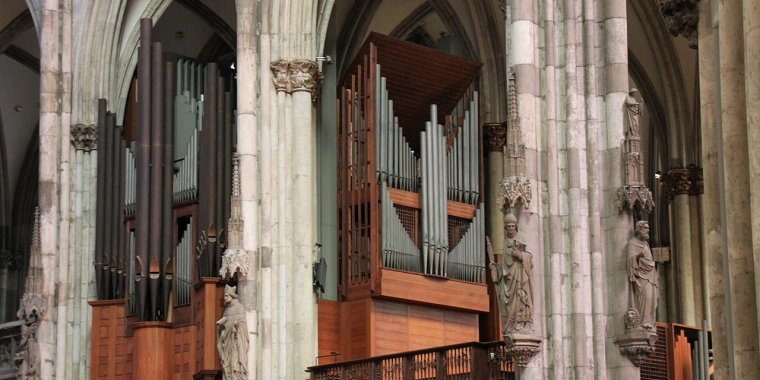| Published in Attractions / Places of Interest |
Kölner Dom, Cologne, Germany
Cologne Cathedral (German: Kölner Dom, officially Hohe Domkirche Sankt Petrus, English: Cathedral Church of Saint Peter) is a Catholic cathedral in Cologne (Köln), North Rhine-Westphalia, Germany. It is a renowned monument of German Catholicism and Gothic architecture and was declared a World Heritage Site in 1996.
It is Germany's most visited landmark, attracting an average of 20,000 people a day, and currently the tallest twin-spired church at 157 m (515 ft) tall.
Construction of Cologne Cathedral began in 1248 but was halted in 1473, unfinished. Work did not restart until the 1840s, and the edifice was completed to its original Medieval plan in 1880.
The cathedral is the largest Gothic church in Northern Europe and has the second-tallest spires. The towers for its two huge spires give the cathedral the largest façade of any church in the world. The choir has the largest height to width ratio, 3.6:1, of any medieval church.
The design of Cologne Cathedral was based quite closely on that of Amiens Cathedral in terms of ground plan, style and the width to height proportion of the central nave. The plan is in the shape of a Latin Cross, as is usual with Gothic cathedrals. It has two aisles on either side, which help to support one of the very highest Gothic vaults in the world.
Externally the outward thrust of the vault is taken by flying buttresses in the French manner. The eastern end has a single ambulatory, the second aisle resolving into a chevet of seven radiating chapels.
Internally, the medieval choir is more varied and less mechanical in its details than the 19th century building. It presents a French style arrangement of very tall arcade, a delicate narrow triforium gallery lit by windows and with detailed tracery merging with that of the windows above.
The clerestory windows are tall and retain some old figurative glass in the lower sections. The whole is united by the tall shafts that sweep unbroken from the floor to their capitals at the spring of the vault. The vault is of plain quadripartite arrangement.

Cologne Cathedral, High Altar. ![]()

Painted glass in the Cologne Cathedral. ![]()
The building is dominated by its huge spires, which are entirely Germanic in character, being openwork like those of Ulm, Vienna, Strasbourg and Regensburg Cathedrals.

The exterior of one of the spires. ![]()
Cologne Cathedral has two pipe organs by Klais Orgelbau, the Transept Organ built in 1948 and the Nave Organ built in 1998.

The Transept Organ in Cologne Cathedral. ![]()
The cathedral has eleven church bells, four of which are medieval. The first was the 3.8-tonne Dreikönigsglocke ("Bell of the Three Kings"), cast in 1418, installed in 1437, and recast in 1880. Two of the other bells, the Pretiosa (10.5 tonnes; at that time the largest bell in the Western world) and the Speciosa (5.6 tonnes) were installed in 1448 and remain in place today.
The 24-tonne St. Petersglocke ("Bell of St. Peter", "Decke Pitter" in the Kölsch language), was cast in 1922 and was the largest free-swinging bell in the world, until a new bell was cast in Innsbruck for the People's Salvation Cathedral in Bucharest in Romania.
M-Sa 06:00-19:30 (May-Oct: 06:00-21:00), Su 13:00-16:30.
Touring the Cathedral is forbidden during Mass. Entry into the cathedral is free but you will be asked for a donation. Admission to the tower costs (2017): €4, reduced: €2, family: €8. Admission to the treasury costs: €6, reduced: €3, family: €12 however, a combined ticket granting you admission to the treasury and tower can be purchased for (regular/reduced/family): €8/€4/€16. No luggage may be carried inside. (Wikipedia, Wikivoyage)
YOU MAY ALSO LIKE






 If you own or manage a travel-related business such as a hotel, a bed-and-breakfast, a restaurant, a pub or a cafeteria, you can create a web page for your business for free on Titi Tudorancea Travel Info. » |

